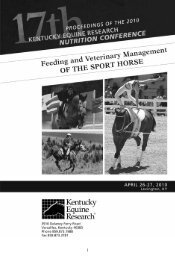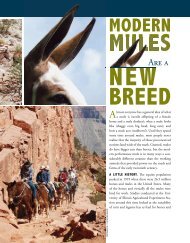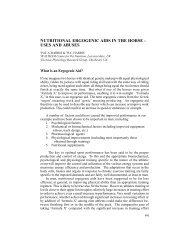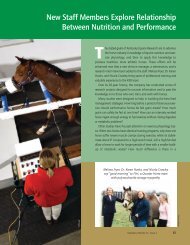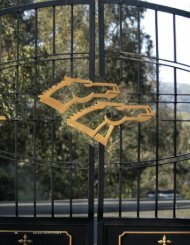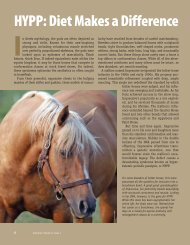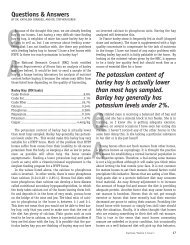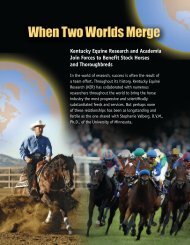Interns Get an Inside Look at Research - Kentucky Equine Research
Interns Get an Inside Look at Research - Kentucky Equine Research
Interns Get an Inside Look at Research - Kentucky Equine Research
Create successful ePaper yourself
Turn your PDF publications into a flip-book with our unique Google optimized e-Paper software.
KEntucKy EquinE REsEaRch<br />
<strong>Interns</strong><br />
<strong>Get</strong> <strong>an</strong> <strong>Inside</strong><br />
<strong>Look</strong> <strong>at</strong> <strong>Research</strong><br />
18 > EquinEws
<strong>Interns</strong> are exposed to m<strong>an</strong>y facets of<br />
equine nutrition <strong>an</strong>d exercise physiology<br />
research. Oper<strong>at</strong>ing the high-speed<br />
treadmill, including the use of heartr<strong>at</strong>e<br />
monitors, is a core competency<br />
for interns, as so m<strong>an</strong>y of the studies<br />
performed <strong>at</strong> <strong>Kentucky</strong> <strong>Equine</strong> <strong>Research</strong><br />
include <strong>an</strong> exercise component.<br />
For <strong>an</strong>y young person contempl<strong>at</strong>ing a career in equine research,<br />
there’s no better way to spend a summer break or post-collegi<strong>at</strong>e<br />
year th<strong>an</strong> being <strong>an</strong> intern <strong>at</strong> <strong>Kentucky</strong> <strong>Equine</strong> <strong>Research</strong> (KER).<br />
Loc<strong>at</strong>ed in the center of <strong>Kentucky</strong>’s famed Bluegrass country, KER<br />
is a priv<strong>at</strong>e comp<strong>an</strong>y th<strong>at</strong> conducts a variety of studies rel<strong>at</strong>ed to<br />
equine nutrition <strong>an</strong>d exercise physiology. Under the guid<strong>an</strong>ce of expert staff<br />
members, visiting researchers, <strong>an</strong>d KER’s in-house veterinari<strong>an</strong>, interns particip<strong>at</strong>e<br />
in every phase of the research protocol.<br />
The KER internship program is offered as either a year-long opportunity<br />
or a three-month summer term. Applic<strong>an</strong>ts must have completed several<br />
years of a college program in equine science or a closely rel<strong>at</strong>ed field. They<br />
also should be comfortable <strong>an</strong>d confident in h<strong>an</strong>dling Thoroughbred horses.<br />
Finally, interns need to underst<strong>an</strong>d the import<strong>an</strong>ce of following protocol for<br />
d<strong>at</strong>a collection, as their duties encompass not just daily horse care but the<br />
actual procedures involved in a treadmill exercise study or feeding trial.<br />
After being selected as research interns, these young adults are swept into<br />
a busy program of equine activities. They are the first staff members to arrive<br />
EquinEws < 19
<strong>at</strong> the farm each morning, <strong>an</strong>d they may need to make l<strong>at</strong>e-evening visits<br />
to one of the barns for a feeding or to keep a precise schedule for blood<br />
sampling. KER maintains about two dozen research horses th<strong>at</strong> r<strong>an</strong>ge<br />
in age from yearlings (the subject of studies on factors affecting skeletal<br />
m<strong>at</strong>ur<strong>at</strong>ion or the effect of exercise on bone density) to horses in their<br />
20s th<strong>at</strong> may be used in feeding trials to compare the bioavailability of<br />
various dietary components. Care of these horses—feeding, grooming,<br />
cle<strong>an</strong>ing stalls, scheduling vaccin<strong>at</strong>ions <strong>an</strong>d visits from farriers—is a<br />
major part of <strong>an</strong> intern’s duties. If you ask the interns, however, it’s the<br />
actual research th<strong>at</strong> provides the most fascin<strong>at</strong>ing part of each day.<br />
Ari<strong>an</strong>e Wehrmaker traveled from Germ<strong>an</strong>y to spend a year as <strong>an</strong><br />
intern, learning skills th<strong>at</strong> she’d never encountered during her years <strong>at</strong> a<br />
university. She weighed horses on <strong>an</strong> equine scale before <strong>an</strong>d after exercise<br />
<strong>an</strong>d monitored heart r<strong>at</strong>e <strong>an</strong>d perform<strong>an</strong>ce intensity when the horses<br />
worked on the treadmill. She commented, “Particip<strong>at</strong>ing in research<br />
has been interesting. I’ve learned to do h<strong>an</strong>ds-on techniques like taking<br />
blood from a c<strong>at</strong>heter, spinning it, <strong>an</strong>d doing separ<strong>at</strong>ions. Interpreting<br />
x-rays for a bone density study is <strong>an</strong>other thing I learned.”<br />
KEntucKy EquinE REsEaRch<br />
20 > EquinEws
<strong>Interns</strong><br />
<strong>Research</strong><br />
horses are often outfitted<br />
in special muzzles. Diets are strictly<br />
monitored during research trials,<br />
<strong>an</strong>d grazing would compromise study<br />
results. The muzzles allow horses to<br />
enjoy exercise while maintaining the<br />
integrity of the research.<br />
At home in Engl<strong>an</strong>d, Nicola Crowley<br />
had developed <strong>an</strong> interest in equine<br />
nutrition because her Arabi<strong>an</strong> mare was<br />
a picky e<strong>at</strong>er with metabolic issues th<strong>at</strong><br />
caused her to have severe muscle cramps<br />
known as tying-up. Nicola applied to<br />
the KER intern program because she<br />
w<strong>an</strong>ted to learn more about feeding<br />
individual horses. After completing<br />
her year of work in the barn, she spent<br />
<strong>an</strong> additional year as a research fellow<br />
with the comp<strong>an</strong>y. In this capacity, she<br />
helped to complete nutrition evalu<strong>at</strong>ions<br />
for horses th<strong>at</strong> had problems or<br />
conditions rel<strong>at</strong>ed to feed m<strong>an</strong>agement.<br />
A number of metabolic abnormalities<br />
in horses c<strong>an</strong> be allevi<strong>at</strong>ed by making<br />
simple ch<strong>an</strong>ges in a feeding program,<br />
<strong>an</strong>d Nicola found s<strong>at</strong>isfaction in advising<br />
owners <strong>an</strong>d trainers as to the best<br />
pl<strong>an</strong> for their specific horses.<br />
EquinEws < 21
<strong>Interns</strong><br />
There is a bal<strong>an</strong>ce between the physical <strong>an</strong>d intellectual<br />
parts of the position, <strong>an</strong>d former intern Sharon Warner<br />
was enthusiastic about this l<strong>at</strong>ter focus. Discussing research<br />
ideas with her instructors <strong>at</strong> the university, Sharon was<br />
frustr<strong>at</strong>ed time after time as she encountered a discouraging<br />
“th<strong>at</strong> c<strong>an</strong>’t be done” <strong>at</strong>titude. Being <strong>at</strong> KER <strong>an</strong>d particip<strong>at</strong>ing<br />
in all phases of a research project, from the design<br />
through d<strong>at</strong>a collection <strong>an</strong>d <strong>an</strong>alysis, <strong>an</strong>d on to the conclusion<br />
<strong>an</strong>d applic<strong>at</strong>ion, was <strong>an</strong> eye-opening opportunity. “My<br />
experience <strong>at</strong> KER has given me a better underst<strong>an</strong>ding of<br />
wh<strong>at</strong>’s feasible <strong>an</strong>d how to structure it,” she said.<br />
Of course, the interns don’t spend all their time in<br />
the barn, <strong>an</strong>d the internships offer unique opportunities<br />
for explor<strong>at</strong>ion, learning, <strong>an</strong>d fun. Taking adv<strong>an</strong>tage of<br />
the resources in central <strong>Kentucky</strong> during their off-duty<br />
hours, some interns have gone on tours of top breeding<br />
farms, visited veterinary hospitals, <strong>at</strong>tended lectures on<br />
equine topics <strong>at</strong> the University of <strong>Kentucky</strong>, <strong>an</strong>d enjoyed<br />
recre<strong>at</strong>ional pursuits as diverse as sky-diving <strong>an</strong>d cave explor<strong>at</strong>ion.<br />
When their time <strong>at</strong> KER ends, they leave with<br />
new skills <strong>an</strong>d a better feel for the type of career they<br />
w<strong>an</strong>t to pursue. M<strong>an</strong>y have stayed in the field of <strong>an</strong>imal<br />
science: Rachel Moxon is a c<strong>an</strong>ine research associ<strong>at</strong>e<br />
with Guide Dogs UK <strong>an</strong>d has had a number of papers<br />
published in professional journals; Sarah Acornley is a<br />
veterinary nurse in Australia; <strong>an</strong>d Abigail Scherer-Hoock<br />
m<strong>an</strong>ages the breeding <strong>an</strong>d genetics of labor<strong>at</strong>ory mice for<br />
the Division of Compar<strong>at</strong>ive Medicine <strong>at</strong> Massachusetts<br />
Institute of Technology.<br />
Tiff<strong>an</strong>y Dobbs exemplifies the idea of using the internship<br />
as a bridge between classroom learning <strong>an</strong>d a career<br />
in equine research. Having earned degrees in applied<br />
<strong>an</strong>imal science with special study in insulin resist<strong>an</strong>ce<br />
from the University of Queensl<strong>an</strong>d, Tiff<strong>an</strong>y had first<br />
applied to work <strong>at</strong> KER’s Australi<strong>an</strong> office, but when she<br />
heard about the research intern program, she jumped <strong>at</strong><br />
the ch<strong>an</strong>ce to spend a year in the U.S. “I really enjoyed<br />
working with the KER team on insulin resist<strong>an</strong>ce research,”<br />
she said.<br />
She also was fortun<strong>at</strong>e to be able to learn from Steph<strong>an</strong>ie<br />
Valberg, D.V.M., <strong>an</strong> expert on equine metabolic<br />
disease, who visited KER to conduct muscle biopsies as<br />
part of a cooper<strong>at</strong>ive research project with the University<br />
of Minnesota. Tiff<strong>an</strong>y made connections with a number<br />
of other industry professionals who welcomed her skills<br />
<strong>an</strong>d enthusiasm. She spent some time assisting with studies<br />
of genetics, reproduction, <strong>an</strong>d nutrition <strong>at</strong> the Gluck<br />
<strong>Equine</strong> <strong>Research</strong> Center <strong>at</strong> the University of <strong>Kentucky</strong>.<br />
Training, riding, <strong>an</strong>d showing third-level dressage horses<br />
<strong>at</strong> a nearby stable took up more hours. Returning to the<br />
University of Queensl<strong>an</strong>d, she has spent the last several<br />
years working toward a doctor<strong>at</strong>e. Her studies focus on<br />
insulin <strong>an</strong>d glucose dynamics during pregn<strong>an</strong>cy <strong>an</strong>d<br />
lact<strong>at</strong>ion of mares <strong>an</strong>d growing foals. “This rel<strong>at</strong>es to the<br />
occurrence of osteochondritis dissec<strong>an</strong>s in Thoroughbred<br />
yearlings,” she explained. “It’s a very large project. I have<br />
some gre<strong>at</strong> <strong>an</strong>d exciting results, <strong>an</strong>d I’m now in the final<br />
stages of completing my doctor<strong>at</strong>e.”<br />
<strong>Get</strong>ting close to the end of their stay in <strong>Kentucky</strong> are<br />
current interns Olivia Y<strong>at</strong>es <strong>an</strong>d Am<strong>an</strong>da Grev. Olivia is<br />
from Engl<strong>an</strong>d, where she earned a degree in equine dental<br />
science. She has a particular interest in the rel<strong>at</strong>ion-<br />
22 > EquinEws
“I am hoping th<strong>at</strong> my summer<br />
spent <strong>at</strong> <strong>Kentucky</strong> <strong>Equine</strong> <strong>Research</strong><br />
will give me the experience<br />
needed for accept<strong>an</strong>ce into a<br />
gradu<strong>at</strong>e program. Experience in<br />
the equine nutrition field is hard<br />
to come by, <strong>an</strong>d I feel especially<br />
privileged to have interned <strong>at</strong><br />
<strong>Kentucky</strong> <strong>Equine</strong> <strong>Research</strong>.”<br />
K<strong>at</strong>hleen Keough<br />
ship between nutrition <strong>an</strong>d digestive disorders <strong>an</strong>d<br />
would like to pursue <strong>an</strong> adv<strong>an</strong>ced degree in equine<br />
nutrition after her internship is completed. Am<strong>an</strong>da<br />
is from Minnesota <strong>an</strong>d gradu<strong>at</strong>ed with bachelor’s<br />
degrees in equine science <strong>an</strong>d <strong>an</strong>imal science. She<br />
would like to earn <strong>an</strong> adv<strong>an</strong>ced degree in the future.<br />
She came to KER because she w<strong>an</strong>ted to gain more<br />
practical experience with horses <strong>an</strong>d equine research<br />
before continuing her educ<strong>at</strong>ion.<br />
Being able to list this type of experience on a resume<br />
is invaluable if <strong>an</strong> intern w<strong>an</strong>ts to pursue <strong>an</strong> adv<strong>an</strong>ced<br />
degree. K<strong>at</strong>hleen Keough, who was a summer intern<br />
in 2011, is now in her last year <strong>at</strong> Trum<strong>an</strong> St<strong>at</strong>e<br />
University. “I have applied to equine nutrition gradu<strong>at</strong>e<br />
programs <strong>at</strong> the University of <strong>Kentucky</strong> <strong>an</strong>d the<br />
University of Florida,” she said. “I am hoping th<strong>at</strong> my<br />
summer spent <strong>at</strong> <strong>Kentucky</strong> <strong>Equine</strong> <strong>Research</strong> will give<br />
me the experience needed for accept<strong>an</strong>ce into a gradu<strong>at</strong>e<br />
program. Experience in the equine nutrition field is<br />
hard to come by, <strong>an</strong>d I feel especially privileged to have<br />
interned <strong>at</strong> <strong>Kentucky</strong> <strong>Equine</strong> <strong>Research</strong>.”<br />
Any university student or recent gradu<strong>at</strong>e of <strong>an</strong> equine studies program who<br />
w<strong>an</strong>ts to sample h<strong>an</strong>ds-on clinical equine research may apply to spend a summer<br />
or a year as a research intern. In past years, young horse enthusiasts from almost<br />
a dozen countries have come to KER to be part of the research team. Without<br />
exception, interns have reported th<strong>at</strong> they have gained knowledge <strong>an</strong>d skills from<br />
their time in <strong>Kentucky</strong>. To learn more about how to apply for this unique opportunity,<br />
e-mail cwhitehouse@ker.com or go to www.ker.com, scroll to the bottom<br />
of the page, <strong>an</strong>d click on Career Opportunities.<br />
EquinEws < 23



